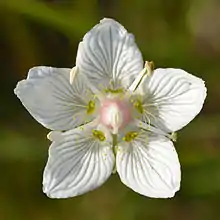| Parnassia palustris | |
|---|---|
 | |
| Scientific classification | |
| Kingdom: | Plantae |
| Clade: | Tracheophytes |
| Clade: | Angiosperms |
| Clade: | Eudicots |
| Clade: | Rosids |
| Order: | Celastrales |
| Family: | Celastraceae |
| Genus: | Parnassia |
| Species: | P. palustris |
| Binomial name | |
| Parnassia palustris | |
 | |
Parnassia palustris, the marsh grass of Parnassus, northern grass-of-Parnassus, or just grass-of-Parnassus,[1] and bog star,[2] is a flowering plant in the staff-vine family Celastraceae.[3]
It is the county flower of Cumberland in England, and appears on its flag.[4]
The name comes from ancient Greece: evidently the cattle on Mount Parnassus appreciated the plant; hence it was an "honorary grass".[5] The specific epithet palustris is Latin for "of the marsh" and indicates its common habitat.[6] It was described by the Greek physician Dioscorides, growing up a mountain in 1st century A.D.[7]
Description
This perennial plant is not a grass, nor does it look like one, but grows from a short underground stem. It has long stemmed heart-shaped leaves, which are 4-12 in (10–30 cm) long. In the centre of the leaf, is the flowering stem. The stem holds a solitary white flower, blooming between July and October. The flower has 5 stamens around the centre. The flower produces a honey-like scent to attract pollinators.[7]
Range and distribution
Parnassia palustris is native to northern temperate parts of Eurasia[8] where it is found in wet moorlands and marshes.[7] It is now extinct in Algeria.[8]
Uses
.JPG.webp)
It was once used in herbal medicines, to treat disorders of the liver. An infusion of the leaves, (similar to a tea) was also used to treat indigestion. When added to wine or water, the leaves are claimed to dissolve kidney stones.[7]
History
While finishing his schooling in the School of Mines at Freiberg from June 14, 1791, to February 26, 1792, Alexander von Humboldt published three articles on plants in the Annalen der Botanik. These were his first of what the world famous explorer would produce. Notably, one was concerning "On the Motion of the Filaments of the Parnassia Palustris."[9]
References
- ↑ BSBI List 2007 (xls). Botanical Society of Britain and Ireland. Archived from the original (xls) on 2015-06-26. Retrieved 2014-10-17.
- ↑ "Parnassia palustris". Germplasm Resources Information Network. Agricultural Research Service, United States Department of Agriculture.
- ↑ "Plants Profile — Parnassia palustris L., marsh grass of Parnassus". U.S. Department of Agriculture — Natural Resources Conservation Service. Retrieved 3 February 2010.
- ↑ "Cumberland Flag". Flag Institute. Retrieved 8 October 2017.
- ↑ "Grass-of-Parnassus". Plantlife. Retrieved 10 December 2010.
- ↑ Archibald William Smith A Gardener's Handbook of Plant Names: Their Meanings and Origins, p. 258, at Google Books
- 1 2 3 4 Press, J. R.; Sutton, Dr D. A.; Tebbs, B. M. (1981). Field Guide to the Wild Flowers of Great Britain. London: The Reader's Digest. p. 155.
- 1 2 "Parnassia palustris L." Plants of the World Online. Royal Botanic Gardens, Kew. Retrieved 15 March 2023.
- ↑ von F. A. v. Humboldt. "Beobachtungen über die Staubfäden der Parnaflia paluftris" Annalen der Botanick. / Herausgegeben von Dr. Paulus Usteri. Drittes Stück. 1792 vol.3, p.7 Accessed Dec 21, 2021
External links
 Media related to Parnassia palustris at Wikimedia Commons
Media related to Parnassia palustris at Wikimedia Commons